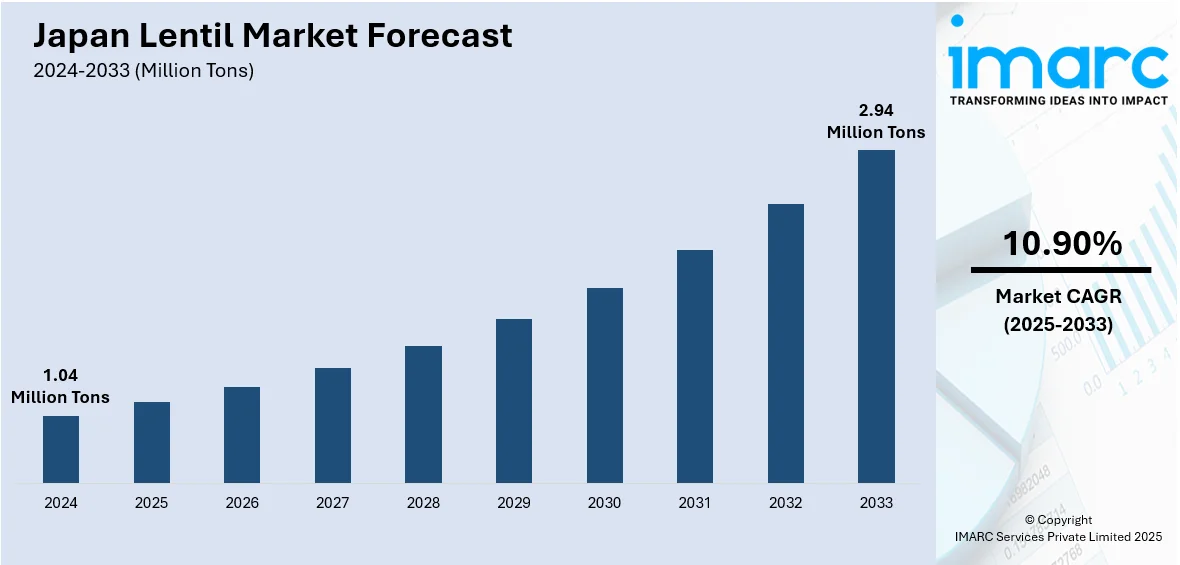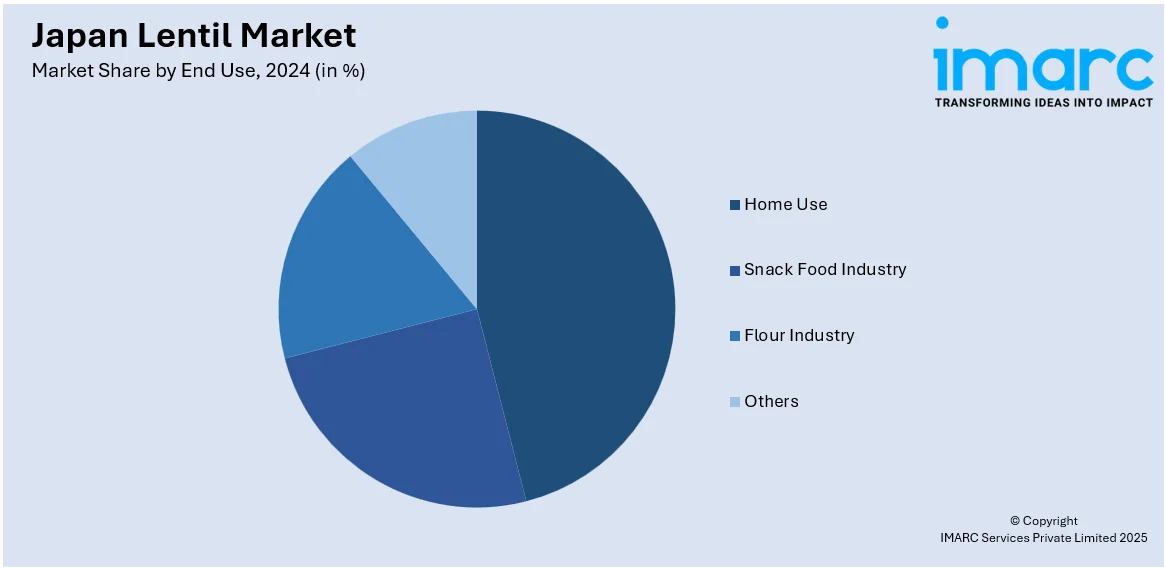
Japan Lentil Market Size, Share, Trends and Forecast by End Use and Region, 2025-2033
Japan Lentil Market Overview:
The Japan lentil market size reached 1.04 Million Tons in 2024. Looking forward, IMARC Group expects the market to reach 2.94 Million Tons by 2033, exhibiting a growth rate (CAGR) of 10.90% during 2025-2033. The market is being driven by the rising health consciousness, increased demand for plant-based proteins, the versatility of lentils in various cuisines, widespread product utilization as an alternative to animal-based proteins, and their nutritional benefits and environmental sustainability.
|
Report Attribute
|
Key Statistics
|
|---|---|
|
Base Year
|
2024 |
|
Forecast Years
|
2025-2033
|
|
Historical Years
|
2019-2024
|
| Market Size in 2024 | 1.04 Million Tons |
| Market Forecast in 2033 | 2.94 Million Tons |
| Market Growth Rate 2025-2033 | 10.90% |
Japan Lentil Market Trends:
Growing Health Consciousness and Demand for Plant-Based Protein
Health and wellness are becoming top priorities for Japanese consumers, fueling a growing demand for nutrient-dense, plant-based foods like lentils. Rich in protein, fiber, iron, and folate, lentils have gained popularity among health-conscious demographics, particularly urban Millennials and Gen Z seeking nutritious alternatives to meat. A growing number of consumers are reducing meat consumption, opting instead for plant-based proteins such as legumes, tofu, and lentils. This shift is reinforced by increasing nutritional awareness. Supermarkets such as AEON and Seijo Ishii have responded by expanding their health food selections, leading to a gradual rise in lentil product sales. Lentils are now featured in a variety of ready-made meals, soups, and salads marketed as high-protein, low-fat options, supporting national initiatives aimed at promoting longevity and preventing lifestyle-related diseases.

Rising Popularity of International and Plant-Based Cuisine
A rising interest in global culinary trends, particularly Indian, Mediterranean, and Middle Eastern cuisines, is reshaping Japanese food culture and boosting the popularity of lentils. As Japan’s foodservice sector adapts to more diverse palates, lentils are making their way into home kitchens, restaurant menus, and a variety of processed food products. The number of Indian and Middle Eastern restaurants in Japan is growing, introducing consumers to lentil-rich dishes like dal, curries, and stews. This culinary curiosity is mirrored online, with a rise in lentil-based recipes, indicating increased experimentation with this nutritious, adaptable ingredient. Retail innovation is also accelerating the trend, with brands like MUJI and Kaldi Coffee Farm offering globally inspired, ready-to-eat lentil soups and salads. Additionally, lentils’ environmental benefits—requiring less water and fertilizer than animal proteins—align with Japan’s growing eco-conscious dining culture.
Japan Lentil Market Segmentation:
IMARC Group provides an analysis of the key trends in each segment of the market, along with forecasts at the region/country level for 2025-2033. Our report has categorized the market based on end use.
End Use Insights:

- Home Use
- Snack Food Industry
- Flour Industry
- Others
The report has provided a detailed breakup and analysis of the market based on the end use. This includes home use, snack food industry, flour industry, and others.
Regional Insights:
- Kanto Region
- Kansai/Kinki Region
- Central/Chubu Region
- Kyushu-Okinawa Region
- Tohoku Region
- Chugoku Region
- Hokkaido Region
- Shikoku Region
The report has also provided a comprehensive analysis of all the major regional markets, which include Kanto Region, Kansai/Kinki Region, Central/Chubu Region, Kyushu-Okinawa Region, Tohoku Region, Chugoku Region, Hokkaido Region, and Shikoku Region.
Competitive Landscape:
The market research report has also provided a comprehensive analysis of the competitive landscape. Competitive analysis such as market structure, key player positioning, top winning strategies, competitive dashboard, and company evaluation quadrant has been covered in the report. Also, detailed profiles of all major companies have been provided.
Japan Lentil Market News:
- October 2024: Wayback Burgers Asia launched Next Restaurant, a fully plant-based chain in Tokyo, offering diverse vegan bento boxes and dishes. Notably, lentils feature prominently in their menu, providing a nutritious and protein-rich alternative in items like lentil-based bolognese pasta and rice gratins.
- March 2024: Supermarket chain Seiyu introduced a private-label “High-Protein, High-Fiber Harira-Style Bean Curry” featuring red lentils in a Moroccan soup-curry hybrid. Each 150g pouch delivers 15.5g protein and 9.6g fiber, retailing at JPY 270.
Japan Lentil Market Report Coverage:
| Report Features | Details |
|---|---|
| Base Year of the Analysis | 2024 |
| Historical Period | 2019-2024 |
| Forecast Period | 2025-2033 |
| Units | Million Tons |
| Scope of the Report | Exploration of Historical Trends and Market Outlook, Industry Catalysts and Challenges, Segment-Wise Historical and Future Market Assessment:
|
| End Uses Covered | Home Use, Snack Food Industry, Flour Industry, Others |
| Regions Covered | Kanto Region, Kansai/Kinki Region, Central/Chubu Region, Kyushu-Okinawa Region, Tohoku Region, Chugoku Region, Hokkaido Region, Shikoku Region |
| Customization Scope | 10% Free Customization |
| Post-Sale Analyst Support | 10-12 Weeks |
| Delivery Format | PDF and Excel through Email (We can also provide the editable version of the report in PPT/Word format on special request) |
Key Questions Answered in This Report:
- How has the Japan lentil market performed so far and how will it perform in the coming years?
- What is the breakup of the Japan lentil market on the basis of end use?
- What is the breakup of the Japan lentil market on the basis of region?
- What are the various stages in the value chain of the Japan lentil market?
- What are the key driving factors and challenges in the Japan lentil market?
- What is the structure of the Japan lentil market and who are the key players?
- What is the degree of competition in the Japan lentil market?
Key Benefits for Stakeholders:
- IMARC’s industry report offers a comprehensive quantitative analysis of various market segments, historical and current market trends, market forecasts, and dynamics of the Japan lentil market from 2019-2033.
- The research report provides the latest information on the market drivers, challenges, and opportunities in the Japan lentil market.
- Porter's five forces analysis assist stakeholders in assessing the impact of new entrants, competitive rivalry, supplier power, buyer power, and the threat of substitution. It helps stakeholders to analyze the level of competition within the Japan lentil industry and its attractiveness.
- Competitive landscape allows stakeholders to understand their competitive environment and provides an insight into the current positions of key players in the market.
Need more help?
- Speak to our experienced analysts for insights on the current market scenarios.
- Include additional segments and countries to customize the report as per your requirement.
- Gain an unparalleled competitive advantage in your domain by understanding how to utilize the report and positively impacting your operations and revenue.
- For further assistance, please connect with our analysts.
 Request Customization
Request Customization
 Speak to an Analyst
Speak to an Analyst
 Request Brochure
Request Brochure
 Inquire Before Buying
Inquire Before Buying




.webp)




.webp)












